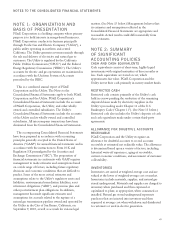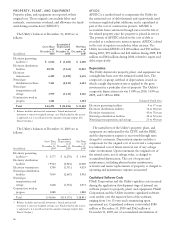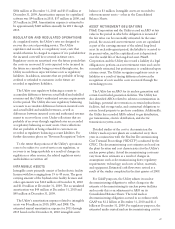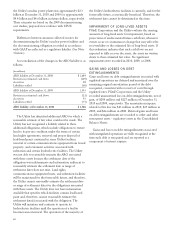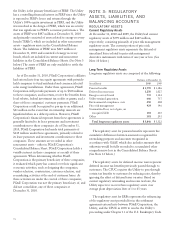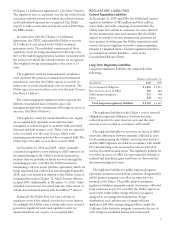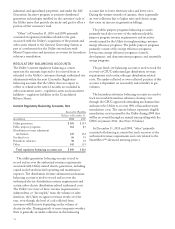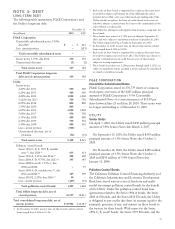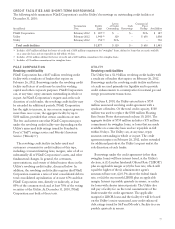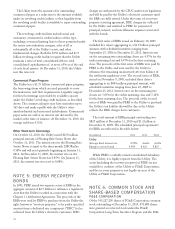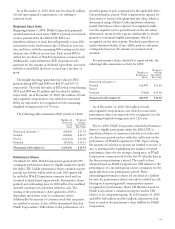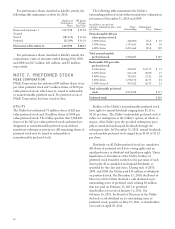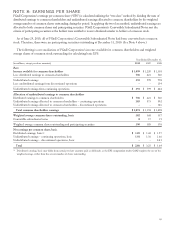PG&E 2010 Annual Report Download - page 77
Download and view the complete annual report
Please find page 77 of the 2010 PG&E annual report below. You can navigate through the pages in the report by either clicking on the pages listed below, or by using the keyword search tool below to find specific information within the annual report.
(“Chapter 11 Settlement Agreement”). (See Note 5 below.)
The regulatory asset is amortized over the life of the bonds,
consistent with the period over which the related revenues
and bond-related expenses are recognized. The Utility
expects to fully recover this asset by the end of 2012 when
the ERBs mature.
In connection with the Chapter 11 Settlement
Agreement, the CPUC authorized the Utility to recover
$1.2 billion of costs related to the Utility’s retained
generation assets. The individual components of these
regulatory assets are being amortized over the respective
lives of the underlying generation facilities, consistent with
the period over which the related revenues are recognized.
The weighted average remaining life of the assets is 13
years.
The regulatory assets for environmental compliance
costs represent the portion of estimated environmental
remediation costs that the Utility expects to recover in
future rates as actual remediation costs are incurred. The
Utility expects to recover these costs over the next 32 years.
(See Note 15 below.)
Price risk management regulatory assets represent the
deferral of unrealized losses related to price risk
management derivative instruments with terms in excess of
one year. (See Note 10 below.)
The regulatory assets for unamortized loss, net of gain,
on reacquired debt represent costs related to debt
reacquired or redeemed prior to maturity with associated
discount and debt issuance costs. These costs are expected
to be recovered over the next 16 years, which is the
remaining amortization period of the reacquired debt. The
Utility expects to fully recover these costs by 2026.
At December 31, 2010 and 2009, “other” primarily
consisted of regulatory assets relating to ARO expenses for
decommissioning of the Utility’s fossil-fuel generation
facilities that are probable of future recovery through the
ratemaking process; costs that the Utility incurred in
terminating a 30-year power purchase agreement, which are
being amortized and collected in rates through September
2014; and costs incurred in relation to the Utility’s plan of
reorganization under Chapter 11, which became effective
in April 2004. Additionally, at December 31, 2010, “other”
included removal costs associated with the replacement of
old electromechanical meters with SmartMeter™ devices.
In general, the Utility does not earn a return on
regulatory assets if the related costs do not accrue interest.
Accordingly, the Utility earns a return only on its retained
generation regulatory assets and regulatory assets for
unamortized loss, net of gain, on reacquired debt.
REGULATORY LIABILITIES
Current Regulatory Liabilities
At December 31, 2010 and 2009, the Utility had current
regulatory liabilities of $81 million and $163 million,
respectively, primarily consisting of amounts that the
Utility expects to refund to customers for over-collected
electric transmission rates and amounts that the Utility
expects to refund to electric transmission customers for
their portion of settlements the Utility entered into with
various electricity suppliers to resolve certain remaining
Chapter 11 disputed claims. Current regulatory liabilities
are included in current liabilities – other in the
Consolidated Balance Sheets.
Long-Term Regulatory Liabilities
Long-term regulatory liabilities are composed of the
following:
Balance at December 31,
(in millions) 2010 2009
Cost of removal obligation $ 3,229 $ 2,933
Recoveries in excess of ARO 600 488
Public purpose programs 573 508
Other 123 196
Total long-term regulatory liabilities $ 4,525 $ 4,125
The regulatory liability for the Utility’s cost of removal
obligations represents differences between amounts
collected in rates for asset removal costs and the asset
removal costs recorded in accordance with GAAP.
The regulatory liability for recoveries in excess of ARO
represents differences between amounts collected in rates
for decommissioning the Utility’s nuclear power facilities
and the ARO expenses recorded in accordance with GAAP.
Decommissioning costs recovered in rates are placed in
nuclear decommissioning trusts. The regulatory liability for
recoveries in excess of ARO also represents the deferral of
realized and unrealized gains and losses on those nuclear
decommissioning trust assets.
The regulatory liability for public purpose programs
represents amounts received from customers designated for
public purpose program costs that are expected to be
incurred in the future. The public purpose programs
regulatory liabilities primarily consist of revenues collected
from customers to pay for costs that the Utility expects to
incur in the future under energy efficiency programs
designed to encourage the manufacture, design,
distribution, and customer use of energy efficient
appliances and other energy-using products; under the
California Solar Initiative program to promote the use of
solar energy in residential homes and commercial,
73




